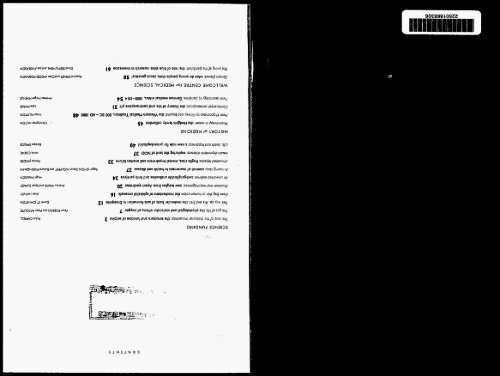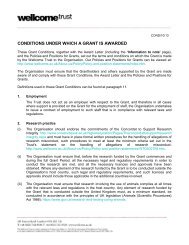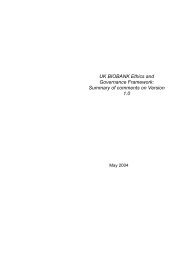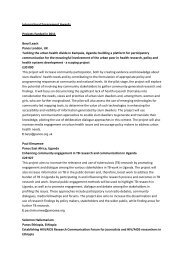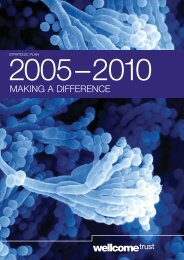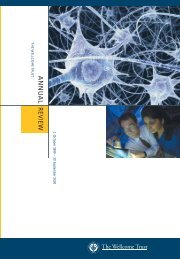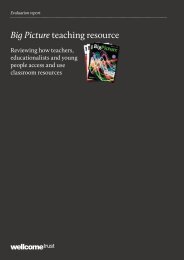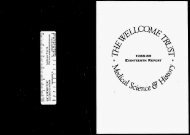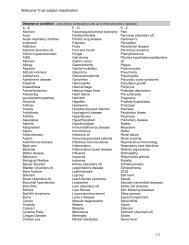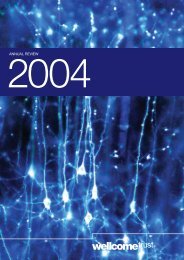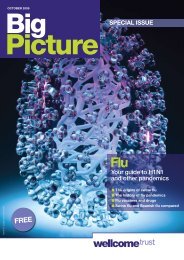The structure and function of serpins
The structure and function of serpins
The structure and function of serpins
Create successful ePaper yourself
Turn your PDF publications into a flip-book with our unique Google optimized e-Paper software.
<strong>The</strong> Case <strong>of</strong> the MolectlEar Mowetnap:<br />
<strong>The</strong> <strong>structure</strong> <strong>and</strong> <strong>function</strong> <strong>of</strong> <strong>serpins</strong><br />
3
4<br />
<strong>The</strong> rerpinr are highly eifenive pmteaie inhibitm. tenaciously<br />
gnpping their pmtcin target So ruccerrful is thc leipin mechanism<br />
that an emodinanly diverie range <strong>of</strong> adaptations has<br />
evolved. In some rerpinr inhibitoiy act~ily is anwaled by partimlii<br />
lig<strong>and</strong>s. In some <strong>of</strong>the rerpini' more disant mlatber.<br />
inhtbtoiy artivly has been lost altogether <strong>and</strong> eherfunnronr<br />
gained. II in the homone ciden thymxine- <strong>and</strong> cortiro.<br />
stemid.binding globulini.<br />
Serpinr aie partiwlady important in the conml <strong>of</strong>pmteoiflic<br />
carcadeder in the blood ansthmmbin inhibits blood clotting.<br />
CI-inhibitor c~nmls mmplement anbation. <strong>and</strong> the inappmpnately<br />
named SI -antitiypGn inhibits the elartare released by<br />
inflammatoiy leukocltei. Abnomalitiei <strong>of</strong> plarma rerpini are<br />
iurptisingiy common. <strong>and</strong> cause a vatiefy <strong>of</strong> direares - mainly <strong>of</strong><br />
the dmilation. Ai many as one in a loo0 people har an amnhmm.<br />
bin abnomab, <strong>and</strong> ths a predspmiuon 10 thmmbosiit.<br />
<strong>The</strong> best-studied abnormal sepini are ~ mam <strong>of</strong>ol-anti.<br />
Wdn. Some IO per cent <strong>of</strong> Eumpeam rin is<br />
wtheiized in homqgoter. it is ineiütiently secreted. Innead.
discovered this daes appearto happen: Z sntwrin rerdiiy<br />
pobmerized imo bng fibnh. whale hepatmfie indw~ns were<br />
found to conrirl <strong>of</strong> emangkd anutvpYin fibnb<br />
<strong>The</strong> model could also explain the rapidly pmgreirive liver cirrhe~<br />
(n 8nfancy. <strong>The</strong> foimation <strong>of</strong> pipmen ir highlyramperalure<br />
mstne. <strong>and</strong> wen comparatively mall incream in the<br />
range 37-41.C lead to vastly arreleraied rater <strong>of</strong> palymetira.<br />
fion. Such temperature ChMgel an occur in childhood feuen<br />
Indeed. m I pre~"ous tliniral nu* <strong>of</strong>U infant$ two children<br />
suddenly developed severe Iwr direaie ahv an unrelated fever.<br />
Confimiatm that fever was a piiiemially rigmfirant ttiggenng<br />
factor came fmm an unexpected IOYX~. DiJean-Yvvonne Bog<br />
fmm Rouen in Fmce had rem the Cambo$e gmup blood<br />
$amplel from pai,emi wnh familial thmmbdic direaie. In one<br />
family. indmduais ruiiered ~ccasional episodes <strong>of</strong> severe<br />
thromboiis aimciaed with plarma levels <strong>of</strong> amnhmmbin that<br />
were sometimes IOW <strong>and</strong> mnetimei nmal. <strong>The</strong> abnomi<br />
amiihmmbn turned out 10 comain an amino acid iubrtnuGon<br />
wh-th created a coniomtional instability - a ~ uieln~ with<br />
an oveneniilne tngger. In the t a tube. the abnoml<br />
amlhmmim slowly Convened tothe inaLtive ïnpgereS fon<br />
at 37'C but changed rapidly I 39'C polymenting in much the<br />
sme way ai Z anutpmim<br />
At fint these invertigattonr 01 mdividual mutations seemed to<br />
pmvide an imereniog but anecdotal study <strong>of</strong> genetc disea$e<br />
<strong>and</strong> moleiular m-hanirmr. Gradually. however. a pattern<br />
was began lo emege. MI only fmm the dwene moleLulai<br />
abnomaLUîS <strong>of</strong>imnhmmbin identified m Cambndge <strong>and</strong><br />
elsewhere k m patiemr wnhthmmbotic dileale. but ab0 fmm<br />
nudm dCImhbnwmcMt8om (n familsa1 angioedem. But<br />
the patem was fninratinghl inmmplate: forexampk. mmc<br />
rare al-amspmiin vaMnts had the rame ilinkal effects a$ the<br />
Z vanant. <strong>and</strong> all0 omed a caniormatimal innabilny reruHing<br />
in pelpme~tion. bin the molecular lnionr affeded qune di6<br />
rent mgions <strong>of</strong>the motccuic<br />
A SHARED PATHOLOGY<br />
ihe explanation for this shared molemlar pathology recently<br />
became apparent when &II the known piaims repin mutations<br />
were plotted an the 1hree.dimenrionaI lemplate nmum<br />
Over haK <strong>of</strong>the 100 mutationr dunered ~n fou? well-defined<br />
domains <strong>The</strong> interpretation <strong>of</strong>thii clme& WI greatly aisiil.<br />
ed bythe completion <strong>of</strong>the rryslul slmcture <strong>of</strong>two funher<br />
lam3 <strong>of</strong>snthhmmbin. eq~ivdlem 10 the paniy sprung <strong>and</strong> fuiw<br />
lrggered mouretrap. <strong>The</strong> tmnmon between these WO fomr<br />
rerub fmm P ttiggetinpindured change <strong>of</strong> iecondary wcture.<br />
uling this reiw af~onbmationt. Anhw Lerk <strong>and</strong> graduate<br />
nudent Jamer Mi$himotL produced I video showing how the<br />
mobile region mwei dvnng mppiog. <strong>and</strong> how spontaneous<br />
ttipgeting leads to polymercation. Amwding to thil Unetic<br />
model. three <strong>of</strong>the mutaionil domains invobe regions ileidy<br />
impliated in the trapping movements - the peptide loop con-<br />
taining the ban region. <strong>and</strong> its pmximal <strong>and</strong> diml hinges <strong>The</strong><br />
founh me was qune unexpected <strong>and</strong> has identified the m ob<br />
~bil~tch'<br />
that cornroll the entry dthe bait reepioo into the<br />
min body <strong>of</strong>the molecule.<br />
Mut11i~1 h any <strong>of</strong>thare domains lead to rpomaneour <strong>and</strong><br />
imppmpriate miornationai changer resulting, in the inhibitory<br />
iepnr. in a shared pathology <strong>of</strong> inaaivation. pol)m&ation<br />
<strong>and</strong> piarma deficiency. In paniwlar. the mutations in the 'Iatdi<br />
Cod this tsmperature ~ensil~ny explain the unu~uaily severe<br />
episodes <strong>of</strong>thmmborir in the Rwen family! Th6 queRion domain that occur in the rare deficiency ~ tiimi af antnryprin<br />
bm& an imediate faxed respame fmm France <strong>and</strong> pmvid. have the lame clinid dieai [ïier <strong>and</strong> lung areare) .a$ the<br />
ed one <strong>of</strong> thore erquirncly warding mmem that .xur<br />
only o~aiionalbf in a Lfetime <strong>of</strong> mearch. "Remakable ..,<br />
exinodinary"- he <strong>of</strong>the Y>: episodes <strong>of</strong>thmmborii in the<br />
family occumd dunng petio& <strong>of</strong> fee< one in a 20 year old<br />
mth pneumonia <strong>and</strong> four in family memben akei other fever-<br />
,ndvting<br />
mutation H the pmximal hinge in the 2 antnryprh vatianr<br />
<strong>The</strong> ,demification <strong>of</strong>thne mobile domaini has ~t only pmvided<br />
a satisfying explanation afthe common mdecdarpathology<br />
in the repin family but has also revealed the mechanisms (on.<br />
tmiling cdonnaiond changes in these proteins. ~n parnutar,<br />
dscare reruns from abmmal&rthat cause an inappropriate<br />
or pmmture change in ~~nformatloh Thur the wlnerabiïny <strong>of</strong><br />
these mobile mechanisms in the $vins pdder a pmlotype<br />
forthe much bmader group <strong>of</strong>diiodes now being recognized<br />
as ionfomational direaies.<br />
<strong>The</strong> Gas <strong>of</strong> L@:<br />
<strong>The</strong> physiological <strong>and</strong><br />
molecular effects <strong>of</strong> oxygen<br />
...<br />
7
O X Y G E N<br />
.. . -.<br />
RV- Orrm~'Imn h ~ (ml o ID *cW ~<br />
that rmtml them. A bener underrt<strong>and</strong>ing would not jun have<br />
implirationt for athletes <strong>and</strong> dimben: it could also have clinical - - ramifications forthe miilions dpeopie with 811neiie1 such II<br />
anhma <strong>and</strong> emphylema, which nowk in IOW levels <strong>of</strong> oxygen in<br />
the body, or commry anery direare <strong>and</strong> cancer. where pmitulac<br />
tirruer are expored to hypoxid.<br />
Nu<br />
Two grnupi funded by the Weltome Tnin are continuing<br />
ûxlodr Iradition <strong>of</strong> hypoxia reIeaKh. by loollng at two dinincl<br />
aspess <strong>of</strong> oxygen renrinp the phyriologml mechanism that<br />
regulate breathing <strong>and</strong> the molecular merhantrmr unde+$<br />
oWen.dependent gene exprerrion.<br />
A PHISlOLOGlCAL APPROACH<br />
At the Vnwnny laboratory aï Phyliolqy in Oxford. Or Peter<br />
Robbinr <strong>and</strong> deaguei areulhgto undenl<strong>and</strong> how pmlonged<br />
hypoxia afleni the breathing ai healthy humans. This queloin is<br />
not 13 nraighüoFnard si n might seem. II the blood levels <strong>of</strong><br />
b31h oxygen <strong>and</strong> carbo dioide change when the oxygen level$<br />
m the asr fall. <strong>and</strong> both thele biton sflecl brealhlng.<br />
E<br />
<strong>The</strong> immediate response to hypoxia il an inreare in vermla.<br />
tim. the volume <strong>of</strong> air bmthed in <strong>and</strong> out per wit time. This<br />
appears to be a dires ellecl Of lowered blood oxygen level$,<br />
Ar ventilillion tirer. however. more arbon dioxide 1s exhaled.<br />
IO le~ll in the blood fali: the cirdation becomes m m ilCa.<br />
line. which. thmugh a reflex rerponre. causes venulatim ta fall<br />
towadi 1:s rUning poinL In a third phare. venUlaiDn increais<br />
again overthe ncn iew days, <strong>and</strong> !hi$ inmase il %stained<br />
white the penon rrmaini at high al6tude -an cfl~t bown as<br />
~entill~~ acdimtization.<br />
O X Y G E N<br />
Many hypotherer have been put ionvard to explain ventilatory<br />
acdimatimion to hypoxu. <strong>and</strong> mon have pmpored that aliui.<br />
Immtion <strong>of</strong>the blood <strong>and</strong> body times is a key phyriological<br />
tngger. This may seem paradoxical since. in the rhon.tem.<br />
rll
O X I G E N<br />
Ifso, what orygen.renring mechanimi might be inwlved! A<br />
L _ ~ Y. in D the USA wodinl .. on mat% has wideme that at lean<br />
pan <strong>of</strong> ~cclimvza~on II due 10 pmgreriive incrediei in the<br />
mfnMIy <strong>of</strong> camrid body chmoreceplos, <strong>The</strong>re mepton.<br />
located rlae to the camtid mer,, are activated by IOW oxygen<br />
le~k. leading 10 an increaie in ventilalion A second US gmup<br />
has pdflmmry endence that prolonged hypoxa induces the<br />
expression <strong>of</strong> new membrane pmmn m camlid body cecep.<br />
101 cells. which could increase their Ieninivny 10 oxygen Thus.<br />
n il posible lhal at lean some <strong>of</strong>the physiological ellecti seen<br />
in people breathing low omen are the relul4 <strong>of</strong> changer in<br />
amid body ~enriiwy mediated by aatvation or imctwation<br />
<strong>of</strong> p r by hypoxit.<br />
"2:<br />
, . . . .<br />
encoding the hormone eyrhmpoietin which stimulatel red<br />
blood cell production <strong>and</strong> thereby increasei the oxygenanying<br />
capac~ty <strong>of</strong>the blood. Tranrcnption <strong>of</strong>the eryhmpoietin<br />
gene has been found 10 be ~ttimulated by hypoxia - a rerponre<br />
to hypoxia nieif. not one <strong>of</strong> its many metabolic ronrequenrer.<br />
By tranrfening the eryhmpoietin gene imo mammalian tell<br />
liner. <strong>and</strong> including dtflerent amounts <strong>of</strong> rumunding DNA.<br />
DI Ratdille <strong>and</strong> colleaguer hive been able 10 identify DNA<br />
~eqvencer required far !his hypoxieinduied conml <strong>of</strong>tranrcnption<br />
<strong>of</strong> pamc~111 importance ira sequem at the 3' end<br />
<strong>of</strong>the gene - the 3' enhancet. Under hypoxic tonditionS. this<br />
$quem is bund by a ÿdm~riptionil activator pmtein known<br />
a< hypoxially inducible nuclear factor (HIF.1).<br />
10<br />
Dr Ratdifle'r gmup ha$ lakm the DNA requencer cwiüolling<br />
eyrhmpoietin tranrdpuon <strong>and</strong> linked them to 'eponef<br />
genes, which encode pmleinr that ran readily be deleRed<br />
when transcription ii activated. Under nomal ciriumrtanrei.<br />
eryhmpoietin is pmduced in the liver <strong>and</strong> Kdney. but hypoxia<br />
was found to induce repmw gene exprestian in 1 much<br />
bmader range <strong>of</strong>cell types - indeed every cell type tened IO<br />
far has expressed the reponer gens in a hypmixically inducible<br />
faihtoh <strong>and</strong> all these cell typer also contain HIF- I. Thur. there<br />
appearr to be I similar mechanian for contmlling gene exprer.<br />
sion in wpponre 10 hypoxia in most if not dl tirruer.<br />
what other genes might be ieniitive to hypoxial Dr Ratclifle<br />
$taled with some educated g u ~ ~ hypoxia r k might be<br />
expected to ~timulle the pmdudon <strong>of</strong> gmwth facton<br />
involved in bloodverrel formation <strong>and</strong> <strong>of</strong>enrymei<br />
involved in gl~olyrh. since glyrdpir cm be used to pmvide<br />
cdldarenergl (ATP) iniheaben
This Way Up, This End First:<br />
<strong>The</strong> molecular basis <strong>of</strong><br />
axis formation in<br />
Drosophila<br />
MOSI orgmismr haw O &&y dirlinguithoblc hcod ond lai!,<br />
~ ~ . ~ ~ ~ ~ ~ p h l r<br />
fiont ond bob <strong>The</strong>re oxet OIC citobiirhed early in embyonic<br />
dcvciopmcnf hlil Tor most onimdr oimoil nothing it known<br />
obovt the prc& mrchaoirmi invdvrd In the fmiffly,<br />
Oiorqhh mymmety is codified in the developing egg, md<br />
~ rcreorch ~ in Umbridgcir beginning to unrorcr~hcmoieculai<br />
~ r ~ ~ p i U i r n n n . . f i h ~ ~ ~ ~ mechinisms ~ ~ , ~ bywhih ~ ~ i there , ~ me$ f ~ ors ~ tprcifed. * ~ ~ ~ i .<br />
<strong>The</strong>awad <strong>of</strong>the 1995 NobeIPtize for Phyiologyor Medrine<br />
to Ed Lewir. Chtirliane Ntirdein4oihsd <strong>and</strong> Eti~ Wielchhaur<br />
was recogn'~n ortheirpimemg or gmtis 10 a~tpe<br />
eady development in Drnrophiio. But it also reIleued the piuoial<br />
mie the fmMy has come 10 plsy in developmental biology.<br />
HOW a fly is pui t~gether ii now undentood in iema?eble<br />
detail. <strong>and</strong> many <strong>of</strong>the ptincipier discovered in OrniophiIo have<br />
twned out to be widely appitable 10 other organism$.<br />
One area <strong>of</strong> early development under cloie rcnniny ir the<br />
mshanirm by which body axer are enab1,rhed nier are highly<br />
arymmettical - heads facing fowads, wings on the back iegr<br />
on the underride. <strong>and</strong> IO OR Inteming~. both head4a.tail<br />
(antem.portetiot) <strong>and</strong> fmnt-to.batk (dom-mntial) poiltitiel<br />
are already established in the unfeniïmed egg Atthe Wellcome<br />
TdCancer Research Campaign Innilute for Cancer <strong>and</strong><br />
Deveiopmental Biology in Cambtidge. Dr Daniel 51 lohnrton<br />
<strong>and</strong> cdieaguer are beginning 10 cianiy the moierdar mcchanimi<br />
by which there asymmettiEI are mated.<br />
I2<br />
DROSOPHILA<br />
A fmrhiy laid Drnrophiio egg il mvghly oval in shape <strong>and</strong> look<br />
almort iymmem~al. in facc the inride <strong>of</strong> the egg is highly polar.<br />
ized. owing to the localized dimbution <strong>of</strong> merrenger RNA$<br />
encoding key pmteinr: bmd mRNA is localized to the anterior<br />
<strong>and</strong> orbr mRNA $0 !he ponetior. In nom1 Ilia. biraid deliner<br />
where the head will form <strong>and</strong> etkordicttatcr where the<br />
abdomen will devebp.<br />
How is this aiymmefry mated1 Eggs begin life in a ~flllmre<br />
lvl~wn II the egg chamber. which is bmed when a Rem tell<br />
divides four times 10 give a cyst <strong>of</strong> 16 ceilr: onne <strong>of</strong>there cells<br />
develops into the wcyte - which will wmtually be the egg -<br />
while the other 15 become 'nune celis', imerconnmed LeIli<br />
fhl rvpply the ooqe With the matetialr 11 needs to gmw <strong>and</strong><br />
deveiop.Artheoo~ytegmwr.theegg chambertaker m a dirtincm<br />
shape. with the ooqe iseifat the ponetior. the rime<br />
celis atthe antetior<strong>and</strong>a tingl~.~diI~y~r<strong>of</strong>q~hhelium-f~llide<br />
ceils - rumunding all I6 gemline celii. How the ooqe<br />
ilimei to o~ccupy the ponm.oiend <strong>of</strong>the egg rhamberir not<br />
dear. bu1 this positioning if eimtial to the ertabiithment <strong>of</strong><br />
both the antao.porletioi <strong>and</strong> dom-venml =CI.<br />
WO* fmm Cr 51 Johnswn's <strong>and</strong> other labs ha revealed that<br />
the key tD axis fomtion is a setier <strong>of</strong> signals relayed between<br />
the developing oocyte <strong>and</strong> iumunding follide cell$. tek to<br />
their own dwicer. ioliicie ceils I the portetior <strong>of</strong>the egg<br />
rhamberaregeneti~aUypmgrammed to adopt an sntetiorfate.<br />
A$ it develops. the Gcyte rends a signai to these follicle tells,<br />
which stops them following the default anietioi pathway <strong>and</strong><br />
'<br />
imtcad Commis them to a posterior fare.<br />
Later. the ponetior foiiide ceils signal back 10 the oocyte <strong>The</strong><br />
eNea <strong>of</strong>thi5 signal is 10 reorganize the intemal scaffolding or<br />
~ y t ~ ~ ~ eooqe, i ~ IpeLiliaiiy t ~ ~ itr miuDtubu~e " krk<br />
Unlike Icaliddmg. mimubules are directional: the labels 'pius'<br />
13
D A D S O P H l L R<br />
Iikeagmwth fmor<strong>and</strong>ta$+d,emadaagmwth faaormeptor.<br />
n is thought that Gurkm pmein pmduced by the oocyte<br />
bmd to the Topedo receptoc M follicle cdlr ükimately. this<br />
modilia g m expmrion in the foilitle relli <strong>and</strong> rommm<br />
them 10 a doml fate.<br />
FRONT FIRST<br />
14<br />
2<br />
IS
From Frog Skin to Human Colon:<br />
<strong>The</strong> mechanisms <strong>of</strong> epithelial crosstalk<br />
16<br />
We key nux in these cells is the abrqtion <strong>of</strong> sodium ions.<br />
Sodim EIUI the cell through a sodium channel at the apical<br />
membrane (the one facing the enema1 envimnmmt) <strong>and</strong> exits<br />
at the baroiateral membrane (which facer body tirrues)<br />
through a rodiumlpotarrium pump: the imported potassium<br />
leak out thmugh a potassium channel ($te above). To replate<br />
sdwm levl. the actiwtier <strong>of</strong>lhe sodium channel muR some.<br />
haw be linked to those <strong>of</strong>the ion vansponen at the bardatatcr.<br />
al membranc. A decade or rc'r work by Pmfmor han Harvey<br />
<strong>and</strong> ioileaguer. fim in France but m m recently in Coh his<br />
identified three mmponenu <strong>of</strong> lhir in~dcellulir imrnalk ryrtern:<br />
pH, ATP 10 ADP ratio <strong>and</strong> calcium,<br />
INTRACELLUIAR pH<br />
We 6m edence that intracellular pH could be significant<br />
sme in the 1980s. with the discovery that the sodium <strong>and</strong> .<br />
poliiiium conductances dfmg Mn epithelia increased mth<br />
increasing pH. Morewer, the efeN w e innaniamots <strong>and</strong><br />
occurred afierphyriologirally relevant Shi& in pH. Literpatch.<br />
clamping rtudier revealed that individual potaiiium <strong>and</strong> sodium<br />
cha~elr are directly modulated by pH. <strong>The</strong> $odiumlpotanium<br />
pump. however. is relatively insemirive 10 intracellular pH.<br />
Two a m <strong>of</strong>the ion transport rynem thus appear to be COY.<br />
pled. via intracellular pH. How might this iwpling be linked to<br />
the contml <strong>of</strong> ion tranipoTi1 Studies in fmg skin revealed that<br />
in1racellulai pH is sensitive to m!ei <strong>of</strong> ion transort. We key<br />
factor appearr 10 be a rodnrdpmton exchanger in the basola.<br />
en1 membrane. whrh pumps pmtonr out <strong>of</strong>the cell <strong>and</strong> thus<br />
increaser intraceiluIrpH. <strong>The</strong> exchangeri'doven by the rodium<br />
gradient imii the membrane, IO any bdd.up <strong>of</strong> $odium<br />
in the cell wII. thmugh ils eiTeitr on pH. inhiba funher $odium<br />
17<br />
inOvx lree abovel. In e kt 8 'ïeedback h W mmtes
E P I T H E L I A L C R O I I I A L I :<br />
CALCIUM<br />
pmbh was resolved when ADP was included. which rhihr Eat wideme that ddiim was involved in cmrrtaik CamC fmm<br />
the ~eninMty <strong>of</strong>the channel imo phfliobgial ATP toncenlra- nudies <strong>of</strong>toid utinary bladder. in which sodium abroiplion il<br />
lions ilk rmrnwe to ATPADP ratim rather thin ATP %reif. inhibited by calcium imophorer. Patch clamp nudier revealed<br />
<strong>The</strong> ATPADP ratio ii integral to lhe coupling bnween the that caicium inhibiü both the sodium <strong>and</strong> the potasium chanpota~innn<br />
charnel <strong>and</strong> the sodiumipotarrium pump. which is a nel, abhwgh in the former raie indredy, Cellvlw calcium lweli<br />
w~i~~~mumer<strong>of</strong>ATP:it~rnpomibleforuptoM)per ran 80 be InflUenCEd by sodium fluxes thmugh the aaRNticI <strong>of</strong><br />
cent <strong>of</strong> an epithelial cell's ATP UK, whui a is active. paariium ye1 another exchanger. I lodiudcalcium exchanger. which<br />
ions flood imo the cell. ATP lwek dmp (<strong>and</strong> ADP levels ne). expels rikium <strong>and</strong> imporb radium. Thk pump is renritive IO<br />
IO the pdar+m channel il opened. Cellular metabolism is inlraceilvlar radium. providing M addnional mechanism for<br />
therefore a potent mxlalk signal.<br />
leedbek CDmml<strong>of</strong> sodium fluxer (se facing page).<br />
Take lhe human col~n. As mmiioned above. aldonemm on<br />
enhance sodium uptake by gut q%h& But il can dro inhibn<br />
chlotide secretion, thereby exening I powedul influente on<br />
body id1 leveli <strong>and</strong> on water retention. Sodium <strong>and</strong> chlotide<br />
ion flow occur piedominamly in inioldi or'mpts', each containing<br />
about 30 dlr. It has been rugpled that chidde is<br />
secreted al the boum <strong>of</strong> oyps <strong>and</strong> sodium abrorted at the<br />
top. but Pmferror Hakey believer that cells exponing chloride<br />
are pedebly able IO absort $odium<br />
It appearr that chlotide secretion is nomaliy dependat ai high<br />
lweli olinuacelluiar calcium which aas indiredy through a cai-<br />
ciumdependent p<strong>of</strong>ariium channel: potadurn efbs *rough<br />
these channeir are "red to mumtrtdance the mwement ol<br />
negatkly charged cidoride ianr Now, immningly, this potarri-<br />
um channel has an unurud pH renyiMry. It is oplimalh. aclke at<br />
19
Mutation <strong>and</strong> Morphogentsis:<br />
New insights from Apert syndrome<br />
One <strong>of</strong>the bemm <strong>of</strong>lha Human Gnome PmJm is Ihm il ipreh<br />
vp ideniijcorion <strong>of</strong> the moleciilor &sir <strong>of</strong>inhetired diseoses by<br />
suggesting 'condidate penet'ro moiyse. Ailhough such diremir<br />
an rare. their rwdy bquea~@ prarider valuable indghU<br />
into normd
EZ<br />
nv
An Unwanted Defence:<br />
Anti-ganglioside antibodies<br />
<strong>and</strong> limb paralysis<br />
Our immune sprjtemr pmiect us imm a huge range <strong>of</strong> organisms<br />
u4irlkl
PROPERTIES OF THE ANTIBODIES<br />
h theory, the cloned nntrganglioride amibodierdamage penph<br />
era1 newel ladmg to muscle deymiion Ifso, the antibodies<br />
hdd bind ganglioeder in nene Wrn For at lean me antibody,<br />
this doer appear to be the case: 8mmunolocalmm studis<br />
havc revealed thai a cloned antibody tan bind to gangiioiider<br />
at munipie siter m nene fbm, including nides <strong>of</strong> Panvier. which<br />
an as 'relay nation? in the tranrmirtion <strong>of</strong> mion potentiak<br />
along myelinated newu.<br />
,I 6 ml yet clear whnher or not all the other cloned atibodier<br />
bind to neumni - <strong>and</strong> thus whether they actualt carne<br />
dilese. <strong>The</strong> fact that the amtbq tha bin& to nodei <strong>of</strong><br />
Ranweralro induces i penpheral neumpathy-like *ilnerr when<br />
lnjected into mce 6 good wsdmce <strong>of</strong> a ca~mtive link <strong>The</strong><br />
adds are thcs wry much in favour. but clear binding <strong>of</strong> other<br />
antibodies to ~ner m the penpheral newous system would<br />
pmvide rearrunng mnfimtion.<br />
Hm do d.reactiue am,bod#er aflect the newel IO whkh hey<br />
bind! AHhoqh mon anemion har been focuied on tmmune.<br />
mediated damage. Dr Willnon bell- a rmmd pornbility<br />
$ho& bt considered - that the aniibodler !Mead imeirere wnh<br />
ganglieride fundon In elTeri they could act as phammlogd<br />
reagent% either as 'blocken' that inhsbn gangloiide or PI anb.<br />
10% Ahkugh there ir wdence <strong>of</strong> inflammatory damage to<br />
new lib- there il dro suppm foi akematwe mechanisms for<br />
example. some meu$ly 11 patients make enremely rapid RGW.<br />
mer inwnrinem wnh the need for edemve mx~ural repair<br />
but conrinmt wih a ~venicle response.<br />
To explo~ these akemativei. Dr Wkon <strong>and</strong> (oliabomtm at<br />
Strathclyde <strong>and</strong> Ohd are iening the elfe- OfaUtoantibOdy<br />
O" a vanay or bi010g~~~i IPtem~. N O ~ or S bnvier are ti
ynemr d p a b with sud diiordm can reergar&e extensively.<br />
<strong>and</strong> may explain why some patienü regain convol <strong>of</strong><br />
mwemen~ If parallel parhwayr do eriP could the damaged<br />
brain be e@ohingthem dvnng recovery1<br />
MODELS IN THE BSIN<br />
Or Daniel Wolpen has memly returned to the LJK afier three<br />
yeas at the Mariachhurenr Innitute dTKhnology in Bonan<br />
At the lnnnute <strong>of</strong> Neumlagy. he II MW iheitigating the neural<br />
comp~~tions invoked 3" two fundamema! aresi <strong>of</strong> motor con.<br />
lml: how doer lhe brain imepte the intomation 11 recmier<br />
fmm the eyes <strong>and</strong> other iemei (semonmoto? intepuon). <strong>and</strong><br />
then dire3 the body to aa accordingly (motor p1anning)l<br />
n O V r M f N 7 C O N T R O L<br />
To #&#gate there pmmrer. Di Wolpen has developed a<br />
Ruble -mimental set-up that dlowr a n movement to be<br />
wry fin& mmmiied Subjear hold a h<strong>and</strong>le anached 10 a<br />
lightweight robotic mnipUlatOn which BO eren compulelrontdled<br />
totter on the h<strong>and</strong> duhg movement Vmd envi.<br />
mnmenü' can th- be mated
area <strong>of</strong>the brain that was lell actwe in Pahmon's patients<br />
than in noml rubjecü (see above). Could underadmy m this<br />
are& known as the %upplememary motor area undcdie the<br />
motorabnomalnies seen in ParCimon'i patiemr?<br />
<strong>The</strong> neural dirniptionr leen in Parkinrotir dseare ruggert a<br />
possible cause forthis underacttivhy. <strong>The</strong> rupplememury mmor<br />
ares rends mnnect8om both 10 the mmor mnex <strong>and</strong> to the<br />
spinal cord. 1s sctMty il influenced by the putamen (pan <strong>of</strong> the<br />
baral panplta). which in Paf6hon'r dseare il innervated by 1<br />
greliy reduced -ber ddopamuie-rmiaYimg nemm This<br />
losi <strong>of</strong> dopaminegie input appeari 10 affect the rupplememsry<br />
molw area: act% in this area WI found to be more nomd<br />
when palientr had taken apomoiphine.which i~reareithe<br />
levels <strong>of</strong> dopamine in the pUtMlen.<br />
E l O V E M f N i C O N T R O L<br />
<strong>The</strong>se nudei wggen that the supplementary -tor area my have P $pedal mle in the performance 01 relf.genented movements<br />
<strong>and</strong> nudm M macaques have rdmed UUS theory.<br />
<strong>The</strong> macaques were cim trained to pdom an arbnrary mvem<br />
m whenevw they raised thek am. a panut was ddivered<br />
10 a faad hopper. Animals in one group were trained 10 raire<br />
their arm wheneverthey wan1ed:the movements were selfinfliated<br />
Thoie in a second group were mined to nise their<br />
am when iky heard a tone: the movemem wre enemalh/<br />
uiggered. men the supplementary mmor conex mi<br />
I -' -<br />
removed however. Lnimali in the fml gmup initiated few<br />
movcmcmi, while those in the setond gmup were much less<br />
aifected (see below).<br />
<strong>The</strong> supplementary motor area is therefore mcial 10 the<br />
direction <strong>of</strong>relFgenerated movementr. It il there movement$<br />
thl are paniculady affected in Parkinron'l pstienü. But why<br />
are patiems leii impaired when enemii cues are provided!<br />
Dr Parrineham turned hi% attenlion to thc lateral nremotor<br />
conex. Like the suppiemernary mmor conex this area rends<br />
connections both to the mmer conex <strong>and</strong> to the spinal cord.<br />
but PEI nudier suggested lhl h was activated namaily or<br />
near normally in Pa+inion'r patiemi. Wovid leions in the<br />
bted premotorcanex akt motor performance m macaques?<br />
<strong>The</strong> animals were trained 10 pull I h<strong>and</strong>le when presented wnh<br />
one ~OIOUL <strong>and</strong> to move h to the leh when presented whh<br />
another. When the brai premolor conex was removed. the<br />
macaques made many ems (see below). ruggening that ihir<br />
area plays an imponant mle in the guidance <strong>of</strong> m~ement by<br />
extemal cue%.<br />
32<br />
PET studies in homm an im$iftenl with this idea Nomi<br />
subject$ were asked to use a computer mouse 10 move a<br />
pointer almg lines - a task in which viruai WEI guide tracking<br />
movements. AI expected. the lmral prrmotor conex was<br />
activated but the rupplemfntary motor canex vm not.<br />
Activation was also noted in the cerebellum. which an influ-<br />
ence the mmor caltex via a relay thmvgh the lateral pmotor<br />
c on ex. This pathway may explain the abilny <strong>of</strong> Palünron'r<br />
patients 10 use visuai CUE$, since the cerebeiium 6 not sliected<br />
in ParCinroin'r diieare.<br />
<strong>The</strong> Oxford <strong>and</strong> London nudiei am helping 10 cianfy the way<br />
the brain commir movement in heakh <strong>and</strong> direare. A clearer<br />
piaure WIII. in time. not only help U$ to undern<strong>and</strong> one <strong>of</strong>the<br />
mon fundamental human skills but dis0 to devire more ratiltlonal<br />
therapies forthore who have. unfanunately. lost such rkdk.<br />
Unwanted Repeats:<br />
b<br />
Fragile sites, mental impairment<br />
r<br />
<strong>and</strong> ovarian failure<br />
33
MUTATIONS AT FRAGILE SITES<br />
34<br />
Also <strong>of</strong> interen are the chmmosomal suroundingr <strong>of</strong>the frag.<br />
ile riter By characfetiting genetic makers doie 10 the fragile<br />
riter, the gmup hopes to idemay makes or gmups <strong>of</strong> makers<br />
that are Co-inhemed with unnuble rnei. Thur. the Salisbury<br />
nvdy II a 1hree.pmnged invenigation: how is repeal innabilny<br />
Iinkd 10 the number <strong>of</strong>repeats. 10 the inteml mur re <strong>of</strong><br />
the repeats <strong>and</strong> 10 the chmmosomal comext afthe fragile riter<br />
THE FIRST THOUSAND<br />
A preliminav anslyrii <strong>of</strong> the first IWO children has jus been<br />
F R A G C L E X SYNDROME<br />
FRAXA sile, <strong>and</strong> the allela cm%d by an individual at these But phapr the mon im'guing dixovay concas mdiualr<br />
mahrriterpmvide acharacleridc'labd'<strong>of</strong>lhntchmmo with?~pennumbabortki(ine~~~<strong>and</strong>prrmu.<br />
soma1 region. <strong>The</strong> mon common pmem at F W 7-3-4+ tation. Thse allder have bem sdgned to a newgoup. the<br />
(each number representing the allele at each maker rite). il 'intemediale' allder (40-60 repals). In the Fm IWO boy.<br />
iamed by mughly halithe population. In irapile X indiduais<br />
this <strong>and</strong> previous mdiei haw uncaverd a &d over<br />
reprerentation Ofthree pallerns - 2-1-3 <strong>and</strong> the related<br />
64-9 <strong>and</strong> 6-44 <strong>The</strong>se chmoroml typer thus seem to<br />
c~ntiln FRAXA sites prediipsed 10 mutation.<br />
<strong>The</strong> 2-1-3 FRAXA d e LI pmbably unmble because it cdnr<br />
a relatively large number <strong>of</strong> CCG repeats. <strong>The</strong> 6-4-5 <strong>and</strong><br />
6-44 pli?. by tonMn. caw 1 nmcfural change: tw, dthe<br />
AGG impuntier M reparaed by more than 10 CGCr <strong>and</strong> this<br />
may mnder FRAXA suscepuble to full mmtbn. i?tenningif,<br />
about a third oiFRAXA cale$ involve maker combination$<br />
x
<strong>The</strong>re finding fvggened that intermedate expmiom at<br />
FRAYA Could have an etTea on cames. Funhermore. th- is<br />
some evidence that the numberoinon.identicaI wins born to<br />
carrier women il also anomalouily high. Interrnin& the hodence<br />
<strong>of</strong> divgow winning is known te increase with matemil<br />
age. <strong>and</strong> premture ommn failure is also age-related - in efien.<br />
the ovay N ~T ou7 <strong>of</strong> egg% abnormaUy early. Could both these<br />
erects dcct premature ageing <strong>of</strong>the waq in FRAYA carrien!<br />
36<br />
To shed light on lhk issue. Pmrerrorjambi is beginning a<br />
study d 60 aflecled familier 10 detcmine the inodence <strong>of</strong><br />
(I) premature wanan railure. (2) iwinniog <strong>and</strong> (3) milcarriaga<br />
<strong>and</strong> ttiromler (enra copia O( a panicuI&r chmmmome. I in<br />
Down 3pdmme):the lattertwo efiects am dm thought to be<br />
indicalon <strong>of</strong> ageing ovatier. lithe inadence <strong>of</strong> some or all <strong>of</strong><br />
lhefe factam is inueaied. this Would pmvide iunher evidence<br />
that iuppriiediy harmless npat expsnrion is in facl dettimen.<br />
1.1 - atrelenting ageing in the ovary. How might this ariw!<br />
In mowe embyogcnerir FMR-i is expressed in the gonads ai<br />
the sex cells undergo mitotic dwirion. Pehapr. rvgaertr<br />
Roierrorjacobr. cell division if slowed during this peiiod. due<br />
ta the presence oi the addnional repem or their eliea on<br />
fMR4. 10 fewer eggs than normal ire pmdured. <strong>The</strong> wpply <strong>of</strong><br />
eggr mightthcn be exhauned prematurely,<br />
Insulin-Dependent Diabetes:<br />
Exploring the l<strong>and</strong> <strong>of</strong> NOD<br />
37
SVan <strong>of</strong> mice that rpominaouriy develop IDDM - nondese<br />
dlabeiic (NOD) mice.<br />
MECHANISMS OF AÏTACK<br />
By SIX memhi <strong>of</strong> age. mvghb 70 per cent <strong>of</strong> female <strong>and</strong> 10 per<br />
cHn <strong>of</strong> male NOD mice show features vep~ similar to thoie <strong>of</strong><br />
human IDDM. IDDM ran a110 be induced byvanrferd reif.<br />
reactive immuns cells imo idvh or newborn NOD mice Sinre<br />
na 41 NOD mice succumb to diabetes. <strong>and</strong> the incidence <strong>of</strong><br />
IDDM vatis signifanUy R lab populations amund the WO&. it<br />
s a*
L@, Death <strong>and</strong> Happiness:<br />
A new role for proenkephalin?<br />
hornlr~hiPMn"~fn~~~~-~~k'<br />
W*nkN*NmrQf*mddm*ceZ<br />
Wellme /"lYI"Ie Lim<br />
eitherruwive whenthey should die. ordre whenüiq are till<br />
needed-indeed. abnomailyregdated apoptorir plqr a mie<br />
in many direarer. Not rurpnsiogly. *en. apoplorii nrearch has<br />
undqone a ~peaamlar boom <strong>and</strong> oiïen exoling new oppor.<br />
tunilier for fundamental <strong>and</strong> clini
A MArKR OF LICE AND DEATH<br />
h &I bcroming increamby apparent that rbrely related molecules<br />
- <strong>and</strong> romesme pmdum aftk same gene - can.<br />
depending on the Liriurnstaocei. pmmotc either death or $UP-<br />
+al Cell$ are thus precanourly poised beween life <strong>and</strong> death.<br />
On the po~il~ve fide. however, a relatwely small change may be<br />
fuflicient 10 tip the mlei in favour <strong>of</strong> IUNIV~I OT death. <strong>and</strong><br />
these changes muld be therape~tically useful.<br />
Pmenkephalin can now be added to ihti list oilwoke& mol.<br />
eculer. For. as well as promoting rvwival, pmenkphalm can<br />
allo be lethal. <strong>The</strong> key to this dual mie appeari to lie in the<br />
invdceikilailocation <strong>of</strong>the protein: the Dundee gmup ha$ found<br />
that in 3 number<strong>of</strong>cell types, such II embryonic (ibroblartr<br />
P R O E N X E P H A L l N<br />
42 43<br />
h l been implicated in amer. in the insppmpMie p"nenrc<br />
<strong>of</strong> sdCreacÜve lymphmltei in ayv)immyne direse. <strong>and</strong> in persinent<br />
inflimmtion aher iniea8m Converidy. inappmptisle<br />
spoptorir has been implicated in the delnion <strong>of</strong> beneliaal lym<br />
phocre populéonr in AIDS, <strong>and</strong> in neuronal lmi in diKars<br />
such a$ Altheimeir or aherhin injury. <strong>The</strong>re M tmuldng<br />
gmundr for investigating the potentid mle <strong>of</strong> pmenhphalin in<br />
there diiedief. since many <strong>of</strong>he cell typu inwlved romdy<br />
exprerr pmenkephalin.<br />
Fvnherin~nigation <strong>of</strong> pmenkephalin my thedore have<br />
practical benefnnr. But the ceneal bioiqigid quenion -8unanswered<br />
why does the pmtein have such difieren1 der?<br />
One pombility is that d celiectt a Lm <strong>of</strong>'pae btinf. as<br />
exemplified by the lkm r*F-Jllinr which CUI act &er as NYC-
Philanthropy in Action:<br />
<strong>The</strong> Hodgkin family collection
individual about whom there II substantial doLumentition in<br />
the aKhive II Thomas Hodgk8n.r father, John Hodgkm <strong>of</strong><br />
PemoOwlle (17661845). who left Waw,cksh$re for London<br />
<strong>and</strong> set up II afutor. He <strong>and</strong> his wife Elzabeth (1768-1833)<br />
(née RiChan: some papes <strong>of</strong>this Sussex Quaker famvly are<br />
1110 m the collection) had two rurriumg sons. <strong>The</strong> elder.<br />
Thomas Hodghn MD or 'Uncle Doctor' 1s he was known to<br />
succeeding generations. was the 6m Hodgbn to enter medicine.<br />
Trarained is 1 doctor in Edinburgh <strong>and</strong> Pans. fmm I 825 he was<br />
employed at Gv'r Hmpiidl os lnrpector <strong>of</strong>the Dead <strong>and</strong> Curator<br />
<strong>of</strong>the Muieum. conduiting f ut op si el <strong>and</strong> creating I coliection<br />
<strong>of</strong> specimens iiiuitrative a system <strong>of</strong> pathology. H,I obrewa.<br />
lion <strong>of</strong> morbid gmmhr m the lymphatic rynem led 10 the lint<br />
deanpiion <strong>of</strong> what was later IO be named Hodgkin's direare in<br />
his honour. However. a tlah with the horpitdr auÿ~crat~<br />
Treasurer. Eeniamin Hamion. reruked in his being parred over<br />
for pmmolion <strong>and</strong> he resigned ~n 1837. Increasingly. he gave his<br />
enw 10 the philanthmpr caulel that had ~Iways occupied hi$<br />
spare time. interests ceninng on inuemgation Ofthe cult~ies d<br />
conquered people5 <strong>and</strong> advo
From Hippocrates to Harugr <strong>and</strong> Beyond<br />
<strong>The</strong> Western Medical Tradition<br />
800 BC -AD 1800<br />
PmieawVw$an NUiTON<br />
W*l
Iimned in scope. <strong>and</strong> the dircovetier ~fmtural scientin%<br />
although interenmg an thmirelver. had not contributed much<br />
10 the maimeMnCe or recovery <strong>of</strong> heahh.<br />
04 hile the nie <strong>and</strong> fall <strong>of</strong> lhu lamed tradnion formi lhc vine<br />
<strong>of</strong> oar hstw d Western d i c m equal anmtim is &en to<br />
nr imemction wRh other foml Of healing. <strong>and</strong> 10 RI development<br />
again? 1 Ihihing social <strong>and</strong> whural barkgmund. <strong>The</strong>re<br />
are iMematke medical theories that were once in favour but<br />
were lhen excluded - Empindrm <strong>and</strong> Methodilm in Antiquity.<br />
IatmphricI ~n the ievemeemh century - a$ well as authos<br />
<strong>and</strong> movementi whose place in the medical pantheon has only<br />
been achieved by omming mixh. <strong>The</strong> Greek Eraiisratur.<br />
8.280 BC. il accepted as a great experimental anatomin. but<br />
forgotten 1s a tlinuin: Panireliur <strong>and</strong> his followerr (n the sixteenth<br />
~enlury are praised fortheirpmtodemirtry.while their<br />
radical mysticirm is r0nven8ently ignored<br />
In all th,% surgery 01c~piei an ambiguous poiition: elite pni~iit-.<br />
an FRC5 n a myal lugeon. are eiieemed, their more<br />
humble quwalemr dirmirred as bonc.renen or wen quacks.<br />
Yet some <strong>of</strong>todais 1pecid1RteL mcluding dentistry <strong>and</strong> ophlhalmdow.<br />
were once regarded II the province <strong>of</strong> quack. <strong>and</strong><br />
for many <strong>of</strong>the rick the miniitratmnr <strong>of</strong> a travelilng drug-rcller<br />
or local blaikrnnh or barmaid might be dl that was available.<br />
Fared ,a,lh ,he ainhonty OfmDdem medr,ne it ir 111 elly<br />
10 iorgct the ml1 pan played in healing in the pdn by phyri.<br />
(Sni, <strong>and</strong>, ~anverrely, ,he impomn~e <strong>of</strong> med,tine -<br />
previous major histotier <strong>of</strong>medicine in that none d its authon<br />
- 1 tlifsicisL 1" arabis <strong>and</strong> three hinotianr - was trained in<br />
medicine. <strong>The</strong>y have come 10 the Weitem medical tradnian II<br />
outside-. II patients not practnionem. <strong>The</strong>y have not themielv~i<br />
shared in the pm
From Deontology to Discipli,<br />
! German medical ethics, 1800-19<br />
I<br />
I ' "<br />
__<br />
Debotes about medicd ethics open hmk bock to ihc oncirni<br />
prcreplr orthe Hippirmtic oath, such 01 nonmoiefiirenre. confi.<br />
dcniidiry <strong>and</strong> prcrervoiian <strong>of</strong>humin bfe. Fmm this pcrtpmire,<br />
the dcreiopmenr almid!al ethics may oppeor 0 scrm <strong>of</strong>dcvio.<br />
tien$ from a iimeierr idrrri. In meni yecm howewr, hirtorionr<br />
hove begun to erpiore the toiid pr<strong>of</strong>errion<strong>of</strong> ond intcileauoi<br />
conditions that *hoped medimi cihirr in defined periods. AL the<br />
Univerriry <strong>of</strong>ourham Dr AndreorHoiger Modile il mmpormg<br />
Germon <strong>and</strong> Bnti$h medid ethics in Ihe IBOOi <strong>and</strong> miy<br />
1900s. <strong>and</strong> hem he prcrenir some inilid infighli. firuring an<br />
Gcrmon drvriopmenir.<br />
In the early nineieemh centuq German docton expetienced<br />
pr<strong>of</strong>ound pmrernonai change. a relull <strong>of</strong> mduittializa1,on.<br />
uri>aazation <strong>and</strong> paupenzation. Al warken migrated to indurinal<br />
regionr. hospmi medme exp<strong>and</strong>ed 10 cope <strong>and</strong> towns<br />
created publicly funded pmi for phyrcianr 10 treat the poor.<br />
Cornpired 10 their predecerran in the eighteenth mtuq,<br />
dmon were ranfmnted with patients from a broad 10m1<br />
spectrum. indudinglhe lower clai~e~. Cholera epldemiir in the<br />
Memnhcna, v , ~ / ~ thrTr, ~ ~ ~ dareare. Sooally-minded phywani. such as Rudoif Vmhaw.<br />
admanirhed thetc colleaguer 10 act as 'advocate$ <strong>of</strong> the pooi<br />
At the same lime. dem<strong>and</strong>s on practical competence in rugeq<br />
<strong>and</strong> ObnetncI increased. culminating sn the so.cnlied uniGed<br />
rncdiial pmferrion (onIlicher Einheitrri<strong>and</strong>). Fint iamduced in<br />
P ~ w 8n a 1852. it abolished the dichotomy <strong>of</strong> lppreni#Celh!P<br />
trained iuqeonr <strong>and</strong> academ8cnlly educated physician$.<br />
Moreover. dmon had new publx health duties to periom. II<br />
54<br />
were expressed. foi innançe. in theloumrl der pmnisdw<br />
Heilhnde. edited by the Mnyential hnian COU~ physician <strong>and</strong><br />
Min pmielror Chnnoph Wilhelm Hufel<strong>and</strong>. Even the old s p<br />
lem <strong>of</strong> remunerating donon with an amual lump rum began<br />
10 fail. In 1823 the Bonn dinidan oitinim Friednch Narre rug<br />
gened that medical iocietier should be founded to collect <strong>and</strong><br />
redinnkne fees. Dlhen favoured the example re1 by the<br />
Kingdom <strong>of</strong> Hanover, which paired I law in 18 18 to limit<br />
licenser for practice in re*m that already had noqh donon<br />
Againnthir bacligmund. doct~nincre8sing~wmteabouttheir<br />
pmrerrional obügatimr. ertablirhing a ïnemv genre that<br />
became known as 'medical deontology' (i&nnic <strong>of</strong>the doa<strong>of</strong>r<br />
duties). This lnerature fomr I major area <strong>of</strong> DI Msehle'r<br />
research. <strong>The</strong> pmtotype was Hufel<strong>and</strong>'s elhical essay 'Die<br />
Verhdirnirre der Amer', which detailed the physician's obliga<br />
tiom to patienü. deaguer <strong>and</strong> roiiay. <strong>and</strong> CM be seen 8s the<br />
bke Pm'val'r Eth:~, Hufelanüs deonlolqy &ad a<br />
~onxwative effort Io uphold &id Mddom in the face <strong>of</strong><br />
pmlarimd conflid <strong>and</strong> %cial change Forthe PwYan dortor<br />
anNim was the fovndation <strong>of</strong> the di pmfprbh <strong>and</strong><br />
atit it ion <strong>of</strong> human life iü MY a~me Acmidmgly. he<br />
rejected abonion <strong>and</strong> my life-horlmhg memm in dying<br />
patiemr. Though refang m the Hipppo~tic oah in this mn-<br />
55<br />
tuL he chiefly wed vrhat pment4ay efhiN rail a 'dippy<br />
slope' argumm ifa doMImade iudgemü ab- the nh<br />
<strong>and</strong>rrcerrity<strong>of</strong>human1ife.hcw8s bwndtobecomeWe<br />
dangernus Inthe -'.<br />
<strong>The</strong> bmdw r-1 rpccuvm <strong>of</strong> patients was &ed in<br />
Hufcl<strong>and</strong>'s mng plea for equal mmmt hdcpndm <strong>of</strong><br />
we& <strong>and</strong> rtatm Echoing Kantisn nhx* he fustheradnuin-<br />
iBed doam nwerto rrgard a patim 8s a 'means' or'merr<br />
objeect <strong>of</strong> a naluml up&mem'. but ahnp asharm's highnt
end'. Smce mlprartice was unlikely to be punished thmvgh the<br />
legal ryrtem. docton vere exhoned 10 linen 10 the mice <strong>of</strong><br />
their 'inner inbunaS. fmally, mniemporaiy mmpetn,~ wnhm<br />
tne pmfewon <strong>and</strong> tanrem foi ils public image was expreried<br />
10 lhe warning newerr0 dtrparage a cdieague. In essence.<br />
Hdel<strong>and</strong> tned 10 maintain the ideal <strong>of</strong>the 'gentleman dartaf.<br />
.
at xhaal: today's young people we not only going 10 gmw up<br />
ma society markedly dilierem fmm !hat <strong>of</strong> earlier geneniionr.<br />
rheyarealrogoinglorhapeil.<br />
GZNETlC FUTURES<br />
Genetic$ iprer pmminemly in the Nmmd Cilnimlum. By the<br />
age <strong>of</strong> lb. rtudents should have been taught many <strong>of</strong> the basic<br />
concepr <strong>of</strong> genetics. ruth as the chemical barir <strong>of</strong> genes. fhe<br />
inhenlance <strong>of</strong> some direaser <strong>and</strong> the pnncipler <strong>of</strong> genetic en@<br />
neenng. But how well do Ithod nudents undent<strong>and</strong> generic<br />
pnncipler indsppreDatP the likely impact <strong>of</strong>the new genetic$!<br />
Do they appmve <strong>of</strong> genetic manipulation <strong>of</strong> plant5 <strong>and</strong> animai$!<br />
To what eneni do they need 10 appreciate the unddying Ici.<br />
ence m order10 come 10 1 conridered viewpoint'kh quer-<br />
1,om ace aff~d~mentalimpartanreifme nun geneialh <strong>of</strong><br />
adults is going 10 coninbule meaningfully to debutel about 1hE<br />
mle <strong>and</strong> scope <strong>of</strong> genetic lechnolo@er in the 21 11 centuv. Yet<br />
we have vev IilUe idea about the bowledge bare <strong>of</strong> young<br />
pei>p!efheirpeicepti~om<strong>of</strong>thene>v~t*r.<strong>and</strong>what they<br />
identify II the maior ilsues.<br />
58 59
i<br />
<strong>and</strong> yiewpoim~ ran be explored they engage the stvdenis <strong>and</strong><br />
therefore. the team belieucr. more reaiin~cally reflect annuder<br />
<strong>and</strong> l ~eli <strong>of</strong> undem<strong>and</strong>ing <strong>of</strong> he ihwti involved.<br />
hpoci~ememben<strong>of</strong>the~eciteamwahthraghhepmber<br />
wnh ~ cbd biology clailei. <strong>and</strong> Shen more detailed iollowvp<br />
intewiewr are held with I sele~tion <strong>of</strong> students in grnupr <strong>of</strong><br />
four. to expbre 8" greaer depth mme <strong>of</strong> the ihei raised in<br />
the clau exerme$. <strong>The</strong> pmjea his generated an em>my)ui<br />
amOum <strong>of</strong>inbmation. whxh mu* now be analysed. Ahhough<br />
iome qumlmwe data have been amassed. the team ha Concentmod on drawing oui general ihemn imm nudemi<br />
respoma. m oderto ademify concepts that they tend 10 find<br />
lmublerome<strong>and</strong>to exploretheirwayr olthinking-facton<br />
that more Iimplistlic IYN~S might oveiioolc while fl II too eady<br />
m drawirmtanlmnr. iomeprrlimiraiypanmha~ emmed.<br />
<strong>The</strong> bel <strong>of</strong> undem<strong>and</strong>ing <strong>of</strong> nudemi in th$ age range II, L<br />
be% vanable: the National Curnrulvm oken makes<br />
dem<strong>and</strong>s on nudenis that are not earily met. given the<br />
wide range oilheir eiirting Ideas. A iurptiringly large<br />
range olm%rcm
R E P E * R C "<br />
Nevenheleu. the way h which roentific dimuenes amally<br />
lead 10 marXetable pmducti - 'innovation' - or impmvemenli<br />
m heakhcare II not well undeotood. <strong>The</strong> IradiiiOnal modcl <strong>of</strong><br />
innovation has been <strong>of</strong> P lin~ai pmcerç pure rereanh (reatcr<br />
a ioune 01 new knowledge. appited reieanh exploiir thii new<br />
afomiaton 10 tackle 1 rp~ific problem. <strong>and</strong> a devebpment<br />
Sage grnerater the pmdvn iticif. Yet II many poliiy<br />
rescanhen <strong>and</strong> anaiyrti have 'ontluded. thii type <strong>of</strong> model I$<br />
to0 ~impiair ln ihe Uaii for Policy Rerearch in Science <strong>and</strong><br />
Mediane (PRISM) at the Wellcome Tm11, models are being<br />
develaped 10 pmuide P bener deitnption <strong>of</strong> innovalion. For if<br />
steps are 10 be faken 10 intenene m the exploifati~n <strong>of</strong> ICImie.<br />
it II ellenila1 that the pricer5 !< fully undemood. IO the<br />
ektr Of such llew-enltoni can acruraieir be predicted<br />
PRISM'S APPROACH<br />
A key challenge II the developmen1 <strong>of</strong>taair 10 moniforthe flow<br />
<strong>of</strong> knowledge withm the innovdim p mes <strong>The</strong> fis1 outpyt<br />
from funding basic Wence II new howledge. al evidenced by<br />
the publiraiion d mearch papes. Secondary efieitr can<br />
include new patents. <strong>and</strong> m Ihc mediial dmm these may be<br />
followed by new diagnostic <strong>and</strong> iherapeutvc pmduttr leading<br />
10 impmuemcnrr n healihcire. PRISM 81 developvig techniques<br />
10 quwbfy thew effçctr r <strong>and</strong> rnnprehenine way<br />
To measure the eflenr <strong>of</strong> fundtng nntegier an the publication<br />
<strong>of</strong> pope". PRKM has developed the Reearth OUfplr Database<br />
(ROD). ROD was established 10 enable funding bodies. <strong>and</strong><br />
a b mearrh m$ttilyliom thcmrelver. to msww a vanety Of<br />
queaionr. includag.<br />
*<br />
.<br />
What cemnbinion does our oqmzauon make to the<br />
pmduflian <strong>of</strong> knowledge in panicularrerearch fields m the<br />
UK <strong>and</strong> woddrnde?<br />
Which types <strong>of</strong> funding have been panrulady ruirerrfui in<br />
terms <strong>of</strong> knowledge pmduflon?<br />
'Nha1 II the geographical dirtnblsn <strong>of</strong> outputs fmm<br />
rneanh rondvned by ourgmntholdm <strong>and</strong> what impan<br />
don !his have on idunna1 aiiiuity?<br />
ROD includes full bibliographi( details <strong>of</strong> a11 allitleS. noter <strong>and</strong><br />
WNS by UK biamedral siienii~ts. together with delads <strong>of</strong><br />
the Io~nel <strong>of</strong> funding knowl led god in each paper. If coven<br />
aboyt 25 WO papes per year fmm 1988 onwardr Smpie<br />
lemhes
organaalioni that pmcnr. tranrfom or modify research res~lll<br />
before pariing them on 10 Other usen.<br />
Fmm thil model emerges the concept <strong>of</strong> 'pmximal uren'<br />
(dore te the sotne <strong>of</strong> knowledge pmduclion) <strong>and</strong> 'diilal<br />
uim' (those funher away). Since new knowledge may flow in<br />
a vansy <strong>of</strong> ways between proxmal <strong>and</strong> diml uren. this model<br />
<strong>of</strong>ihe innovation pmcelr more cloiely resemble5 a web or<br />
nelwotklhma lhearrhiin.<br />
<strong>The</strong> dlagram on page 63 ii a simplified innovation web for<br />
phamCeUiiLdl dmgr meaith hi thtl example the pool <strong>of</strong><br />
knowledge emegingfmm h w rereanh lr used not only by<br />
the pharmareutral industry but a110 by regulator/ bodies <strong>and</strong><br />
leNiie indvlüiel(e8. tmumce companier). Phamceeutral<br />
cornpanier both use this pool <strong>of</strong> knowledge <strong>and</strong>. through their<br />
own subrraniial R8D pmgrammer. add to 11.<br />
This example, wifh nr numemus


